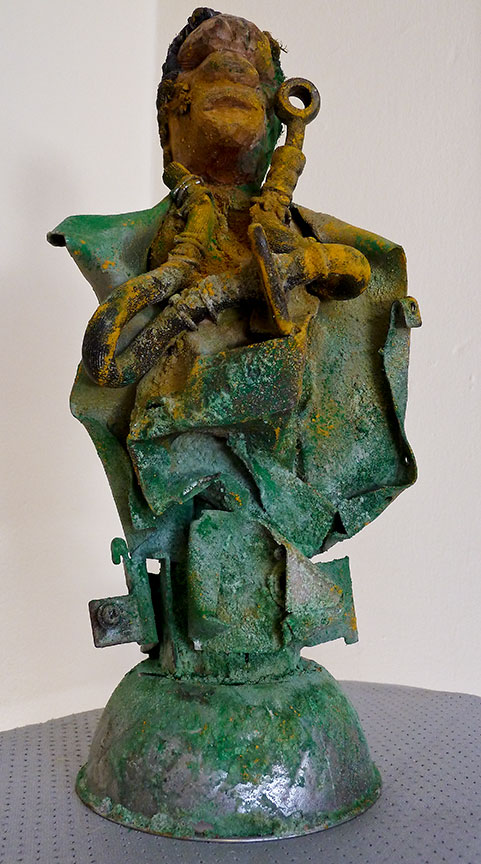So the thing is that Haiti is a difficult place right now; but "Haitian art" -- as the entire range of styles, genres and artists has often been reduced to -- is thought of by the uninformed as happy, colorful canvases depicting village scenes, landscapes and jungle animals. There is much more, of course; and the contemporary artist's inclination is to make work, which reflects the landscape that is now. Enter the age-old conundrum: should artists allow the "sale" potential of a piece to influence their art? You know, just add a dog in the background, and someone will buy it.
It's easy enough to say no, no, no. Never let the reality of empty pockets affect your work! That's selling out. You are not a real artist. But how do you know that that whacked out installation you once saw at the Whitney, the one which included fake vomit on the floor, wasn't created with a certain market in mind; the one that would always scorn a figurative work, never mind consider buying a landscape. We'll never know for sure what lies in the artist's psyche; the smart ones won't tell. However, I would venture to guess that most artists just do their thing and worry about whether it sells later.
Which brings us back to Haiti, and the three artists whose works I will be showing next month (opening on Saturday, April 2nd) at Galerie Lakaye, my Los Angeles gallery of 20 years, which specializes in Haitian art. The artist known as Cheby, a Port-au-Prince-based sculptor currently sojourning in Long Beach, is part of an artist collective known as Atis Rezistans or the artists of the Grand Rue (Main Street). As anyone who knows will tell you, this work is made of recycled debris found in the city's neighborhoods and junkyards. As Anthony Bourdain found when he visited their studios, it does not attempt to present a glossed up version of Haiti. And yet, the small sculptures that the artist brought with him, most no taller than 16" and powdered with yellow, green, red and blue pigment, seem to me like veritable gems. The monotypes and paintings of the artist known as Killy don't make you want to smile -- the artist says he paints only the everyday reality of Haiti -- but they do make you stare. In fact, it's hard to look away. It is strong, evocative stuff, and it takes your breath away. Karl Jean-Guerly Petion's mixed media pieces are patently political but with a whimsical and lyrical quality which moves most people to seek out the artist in order to ask the time-worn question: what were you thinking when you did this?
At its best, art doesn't seek to satisfy, it tries to inspire. And regardless of whether it moves one to feel joy or sadness, a rippling of energy up the spine, or engenders a dialogue about the likelihood of resulting sales, the most important factor is whether it makes you feel. And judging from the outpouring of support for the people of Haiti, which followed the 2010 earthquake, Haiti inspires deep emotions in people from all over the world. Just ask her artists.
New Works by Cheby, Killy and Petion opens Saturday, April 2, 2011 at Galerie Lakaye in Hollywood, CA. 7:00-10:00PM. Exhibit runs through May 2nd. 323-460-7333. www.galerielakaye.com.
The gallery is also launching its Artist Tool Drive on April 2nd. Everyone is asked to bring a tool for artists in Haiti. Old or new, manual or electric, all tools are welcome. They will be put to good use by the artists! Tool collection will continue until November 1, 2011. Sponsors for transportation costs to Haiti are welcome! For more information please visit the galerie Lakaye website.

Untitled mixed media sculpture by Cheby
